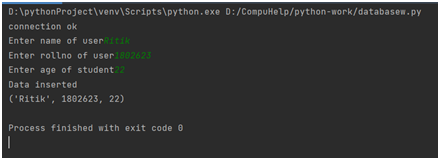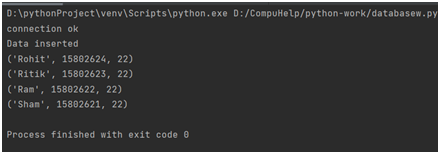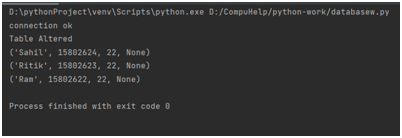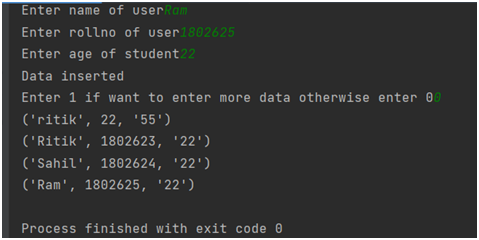Database Connectivity in Python
In Database Connectivity, we will learn the steps to connect the python application to the database.
There are the following steps to connect a python application to the database.
- Import mysql.connector module
- Create the connection object.
- Create the cursor object
- Execute the query.
Some important points to remember before creating connection using mysql.They are as follows:
# check mysql module is installed or not
# Install mysql Database Management System in your machine
# or install xampp in your machine.
# and keep mysql dbms start before connecting to the database using python
#to make connectivity to mysql first we need to install mysql-connector-python
#by using command : pip install mysql-connector-python
# or if you are using pycharm : use File->settings->project-python project
#python Interpretor then press + available packages->find the following packages amd install packages
# 1 mysql-connector
# 2 mysql-connector-python
# 3 mysql-connector-python-rf
# then restart pycharm again
# the pycharm is ready to connect to the mysql or maria db
Example of Database Using mysql
import mysql.connector
mydb=mysql.connector.connect(
host="localhost",
database="test",
user="root",
password=""
)
print("connection ok")
mycursor=mydb.cursor()
#mycursor.execute("show tables")
#mycursor.execute("desc student")
mycursor.execute("insert into student values('sunil',234,6700,500)")
print("data saved :",mycursor.rowcount)
mydb.commit()
mycursor.execute("select * from student")
print(mycursor.rowcount,"rows retrieved")
for x in mycursor:
print(x)
MySql Connectivity with Python
Following points are needed before creating connection with mysql.
- You need a web servers installed in your device(Eg.xampp)
- Start the xampp server on your machine and start apache and mysql.
- Open pycharm and go to file>settings>project interpretor
- Then press + to add packages
- Add the following packages:
- Restart pycharm after installing packages
mysql-connector |
mysql-connector-python |
mysql-connector-python-rf |
Now the program is ready for sql connectivity
To import the package to your program:Syntax:import.mysql.connector
Creating table in database
import mysql.connector
mydb=mysql.connector.connect(
host="localhost",
database="test",
user="root",
password=""
)
print("connection ok")
mycursor=mydb.cursor()
mycursor.execute("Create table table1(name varchar(10),rollno int(10),age int(5))")
print("table created")
Output

Inserting data into the table
import mysql.connector
mydb=mysql.connector.connect(
host="localhost",
database="test",
user="root",
password=""
)
print("connection ok")
mycursor=mydb.cursor()
#mycursor.execute("Create table table1(name varchar(10),rollno int(10),age int(5))")
mycursor.execute("insert into table1 values('Ritik',1802623,22)")
mydb.commit()
print("Data inserted")
Output

Retrieving data from the table
import mysql.connector
mydb=mysql.connector.connect(
host="localhost",
database="test",
user="root",
password=""
)
print("connection ok")
mycursor=mydb.cursor()
mycursor.execute("select * from table1")
for x in mycursor:
print(x)
Output

Printing table column names using cursor
#Printing table column names using cursor
import mysql.connector as sql
con=sql.connect(host="localhost",user="root",password="",database="compuhelp")
mycur=con.cursor()
mycur.execute("select * from student")
mycols=mycur.column_names
#the following code to print column names
print("----------------------")
for cols in mycols:
print(cols,end=" | ")
print("\n----------------------")
for row in mycur:
print(row[0]," | ",row[1],"|",row[2])
print("------------------------")
Taking input from user and entering into database
import mysql.connector
mydb=mysql.connector.connect(
host="localhost",
database="test",
user="root",
password=""
)
print("connection ok")
mycursor=mydb.cursor()
name=input("Enter name of user")
rollno=input("Enter rollno of user")
age=input("Enter age of student")
mycursor.execute("delete from table1")
mycursor.execute("insert into table1 values(%s,%s,%s)",(name,rollno,age))
mydb.commit()
print("Data inserted")
mycursor.execute("select * from table1")
for i in mycursor:
print(i)
Output

Deleting all content from table
import mysql.connector
mydb=mysql.connector.connect(
host="localhost",
database="test",
user="root",
password=""
)
print("connection ok")
mycursor=mydb.cursor()
name=input("Enter name of user")
rollno=input("Enter rollno of user")
age=input("Enter age of student")
mycursor.execute("delete from table1")
mycursor.execute("insert into table1 values(%s,%s,%s)",(name,rollno,age))
mydb.commit()
print("Data inserted")
mycursor.execute("select * from table1")
for i in mycursor:
print(i)
Output

Deleting specific content using where clause
import mysql.connector
mydb=mysql.connector.connect(
host="localhost",
database="test",
user="root",
password=""
)
print("connection ok")
mycursor=mydb.cursor()
mycursor.execute("delete from table1 where rollno=15802621")
mydb.commit()
print("Data inserted")
mycursor.execute("select * from table1")
for i in mycursor:
print(i)
Output
Before Deleting

After Deleting

Updating data in the table using where clause
import mysql.connector
mydb=mysql.connector.connect(
host="localhost",
database="test",
user="root",
password=""
)
print("connection ok")
mycursor=mydb.cursor()
mycursor.execute("UPDATE table1 SET name = 'Sahil' WHERE rollno = 15802624;")
mydb.commit()
print("Data Updated")
mycursor.execute("select * from table1")
for i in mycursor:
print(i)
Output
Before Updating

After Updating

Alter table add column
import mysql.connector
mydb=mysql.connector.connect(
host="localhost",
database="test",
user="root",
password=""
)
print("connection ok")
mycursor=mydb.cursor()
mycursor.execute("ALTER TABLE table1 ADD Email varchar(255)")
mydb.commit()
print("Table Altered")
mycursor.execute("select * from table1")
for i in mycursor:
print(i)
Output

Alter table delete column
import mysql.connector
mydb=mysql.connector.connect(
host="localhost",
database="test",
user="root",
password=""
)
print("connection ok")
mycursor=mydb.cursor()
mycursor.execute("ALTER TABLE table1 DROP COLUMN age")
mydb.commit()
print("Table Altered")
mycursor.execute("select * from table1")
for i in mycursor:
print(i)
Output

Taking multiple user inputs to enter into table
import mysql.connector
mydb=mysql.connector.connect(
host="localhost",
database="test",
user="root",
password=""
)
print("connection ok")
i=1
while i==1:
mycursor = mydb.cursor()
name = input("Enter name of user")
rollno = input("Enter rollno of user")
age = input("Enter age of student")
mycursor.execute("insert into table1 values(%s,%s,%s)", (name, rollno, age))
mydb.commit()
print("Data inserted")
i = int(input("Enter 1 if want to enter more data otherwise enter 0"))
mycursor = mydb.cursor()
mycursor.execute("select * from table1")
for i in mycursor:
print(i)
Output

Checking changes in Database server through CLI(command-line interface):
- Open cmd and change the working directory to the path of Xampp folder by
usingcd command - Run mysql server using the command:
- The connection with the server will begin
- Use show database; command to check all databases in the server.
- Now to use a particular database execute the use command
- Execute show table commands to show all tables in the database
- Now you can run sql queries to perform operations on data and check
changes in database through CLI
Syntax: mysql -u root
Syntax: use database_name


